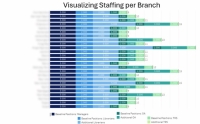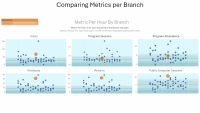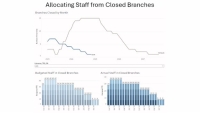Adaptable Staffing Model
Brooklyn Public Library
Innovation Synopsis
In 2024, BPL developed an innovative staffing model to optimize library branch operations through a logical and data-informed approach. Our unique algorithm evaluates staff roles, location size, and usage metrics to recommend how to deploy personnel, providing a flexible framework for new or existing branches. The model ensures efficient resource allocation, anticipates potential budget impacts, and adapts to community needs while preserving each branch's unique character and enhancing service delivery across all locations.
Challenge/Opportunity
Large urban libraries face challenges in staffing due to varying branch sizes, community demographics, and service offerings. At BPL, with 61+ locations, budget cuts exacerbate this issue, requiring optimized resource allocation. Our Data Informed Staffing model visualizes the impact of each staff role within a branch, allowing precise adjustments while maintaining each branch's unique character and addressing community needs.
This flexible framework adapts to branch openings, closures, and renovations, ensuring smooth and structured transitions. By leveraging data from similar branches, we estimate staffing needs accurately and then adjust based on usage metrics.
It also aids in determining staffing for new initiatives, like teen centers, to meet emerging demands effectively.
Additionally, the model supports budget advocacy by demonstrating how staffing reductions affect service delivery, which is vital given that staff expenses are a significant budget component.
Key Elements of Innovation
Our model:
Includes baseline staffing for the smallest branches with our three branch manager roles plus age-level specialist librarians and clerical staff.
- Scales up with additional service points, floors, and specialized areas (e.g. computer lab, teen center).
- Considers metrics, adding additional appropriate roles if a metric is >175% of the median (e.g. high circ might add clerical staff, high programs might add librarians).
- Allows managers to adjust staffing based on emerging neighborhood trends and needs, ensuring a tailored approach.
- Integrates with facilities planning, so we can forecast the reallocation of staff from branches closed for construction, maintaining operational efficiency.
- Helps us anticipate the impact of budget cuts on services and allows us to optimize existing staff.
Our comprehensive, data-informed approach ensures sustainable and efficient library operations, enhancing service delivery across our branches.
Achieved Outcomes
Using this model, we have:
- Calculated staff needed for new and significantly renovated branches
- Understood the impact of adding new service areas like teen tech centers
- Rebalanced and prioritized vacancies based on percent variance from the model
- Understood where vacancies can be addressed by shifting staff from branches with planned renovation closures
- Quickly responded to proposed budget cuts, easily demonstrating service impacts
In the coming year, we will work to operationalize the model’s findings, automate data updates, and XX to make it more readily available to staff systemwide. Thus, the model will allow us to be transparent in our staffing decisions and ensure that each branch’s needs are evaluated consistently while continuing to factor in local community needs.



